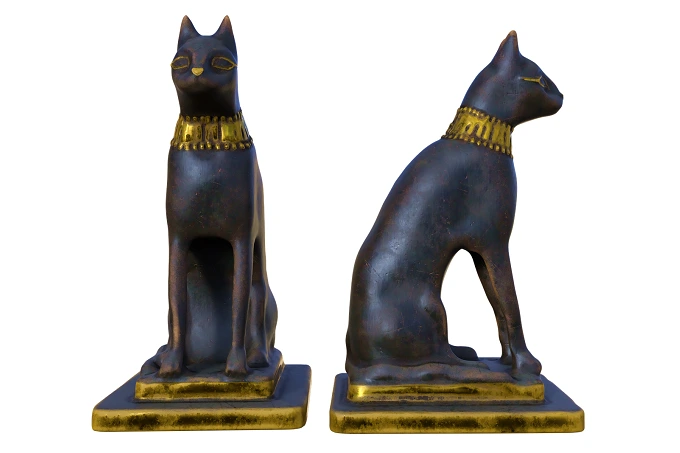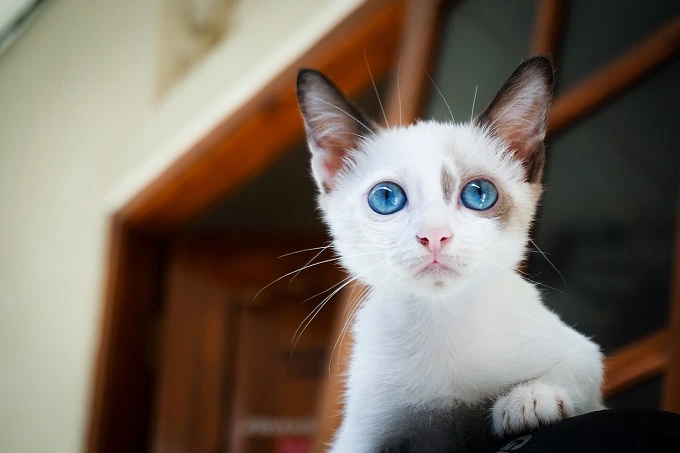The role of cats throughout history: From Ancient Egypt

Until recently, it was believed that cats originated in Egypt, but archaeological finds have shed more light on the domestication of cats. The oldest known evidence comes from Cyprus in the form of a tomb where a man and a cat have buried together nine and a half thousand years ago.
Since cats are not indigenous to Cyprus, the human population must have brought them to the island when they migrated there. The burial is part of the Neolithic site of Shillurokambos and predates Egyptian depictions of cats by about four thousand years. However, let’s see some of the roles of cats throughout the history of humans.
Early evidence
Evidence indicates that cats were domesticated in Chinese civilization around 3500 BC, although as many as four feral cat ancestors have been identified. However, all cats in modern China are descended from the African wildcat, suggesting that this subspecies replaced domesticated cat breeds in China as a result of the opening of the trade Silk Road and contact with civilizations in the Middle East, as well as Rome.
Looking at the history of cats, it is extremely difficult to pinpoint exactly when they became domesticated, but the evidence points to them being “commensal pets”. Like rats, mice, sparrows and other animals living in urban areas, it is likely that cats were attracted to human settlements as a result of the presence of other animals there.
Their relationship with human society began as a convenient symbiosis, where humans attracted parasites they needed to get rid of, which turned out to be what the cats ate. It didn’t take long for people to realize that their new neighbors would be very helpful in keeping pests from eating the stored grain. Thus, the history of cats became linked to human society and the growth of civilization.
Ancient Egypt
Contrary to popular belief, cats were not worshiped in Egypt, but they were highly revered. For over three thousand years, cats have been an integral part of Egyptian social and religious practice, being represented in art and as animals of great respect. They were considered the personification of fertility, justice and power and were synonymous with several deities, the main of which was Bastet, depicted with a cat’s head.

Initially, the goddess was depicted with the head of a ferocious lion, but as Egyptian society developed, so did their deities, and later Bastet was depicted with the head of a domestic cat. Cats were revered not only for their ability to control vermin but also for their ability to kill poisonous snakes. Thus, they were considered not only hunters, but also protectors, and had a high status in Egyptian society.
The history of cats in Egypt represented a significant part of the economy. There were special cat cemeteries where cats were mummified and buried. Vast sums of money were required for the extensive breeding of cats, as well as the resin and embalming fluid required for mummification. They were depicted in works of art and on the walls of tombs, where they were shown accompanying the dead in the afterlife.
In ancient Egyptian civilization, cats were popular across all class ranges. Pharaohs often kept big cats as pets and made gold jewelry for them. The poorer classes obviously couldn’t afford it, but cat-patterned jewelry was very popular.
Ancient Greece and Ancient Rome
Cats were widely believed to be introduced to classical-era Greece and Rome around the fifth century BC by Phoenician traders who sailed the Mediterranean. The earliest depiction of cats in Greek civilization comes from two coins from the mid-fifth century BC depicting prominent figures from the Greek colonies playing with their pet cats on the Italian peninsula.
As with all cultures, the Romans and Greeks considered cats useful in controlling vermin populations, but they were not the first animal to do so. A similar honor went to weasels and ferrets. However, this state of affairs has changed, and cats have been recognized for their excellent ability to catch mice, as well as for their enthusiasm in this matter.
Their use to protect grocery stores was just the beginning. The Roman legions kept cats in forts not only to protect food stores but also because the rats liked to chew on the skin, thereby damaging armor and equipment. Therefore, cats proved to be a useful accompaniment to Roman soldiers both at home and in the field. Soldiers often saw cats as talismans and companions. In Roman mythology, cats were representatives of freedom and were depicted as accompanying the goddess Libertas.
Middle Ages
In the Middle Ages in Europe, cats continued to perform their duties as mousers but did not enjoy the respect that they received in earlier eras. Religious dogma intervened, and cats were often depicted as tools of the devil and considered animals that accompanied witches and heretics. This belief is beautifully illustrated by Walter Map in 1180, who wrote: “The devil descends like a black cat before his devotees. The worshipers turned off the light and approached the place where they saw their teacher. They look for him and, having found him, kiss him under the tail.”
This hatred was taken up by the Church, which often accused heretical groups such as the Cathars of associating with and even worshiping cats. In 1484, even the Pope declared that cats are the favorite animal of the devil and the idols of witches. The nuns and monks often ignored the Pope’s convictions in this regard. Cats were the only animals allowed into the monasteries for the main service they provided
In Scandinavia, the Norwegians had a good relationship with cats, especially as they lived in longhouses with all other domesticated animals. The Vikings kept cats on their boats as they crossed the high seas and waterways of Europe, not only to keep pests at bay but also to bring good luck. The Scandinavian goddess Freya was often depicted riding a chariot drawn by two big cats named Bygul and Triegul.
In the Middle East, cats were thought of very differently from their counterparts in Europe. The Muslim world had great respect for cats, and it is said that the Prophet Muhammad loved cats and treated them well. Some cities even had charities that looked after street cats. This trend continues today, especially in places like Turkey, where cats can be seen everywhere in Istanbul, where they are loved and cared for.

Pre-Victorian England
Many people kept pets! Pet ownership was considered ostentatious and frivolous. Dogs and cats were expected to be working animals, earning their living by doing duties, not beloved family members. However, attitudes began to change in the late eighteenth and early nineteenth centuries.
Owning a pet came to be seen as an exercise that added value to the family. Having a pet was also considered helpful in teaching children about responsibility. Dogs have gone through a rapid transition from workers to important family members who have added their special love to the family unit. They were considered the embodiment of the values of the British – loyal, courageous, steadfast, and brave.
Cats, however, were still heavily maligned and considered treacherous, and their association with witches persisted. Thus, their position in society was reduced to the duties of mousers. It wasn’t until the late nineteenth century that the history of cats began to change.
The first person to set up a cat show in England was a man named Harrison Weir, an animal enthusiast who kept pigeons, dogs, rabbits, and poultry as pets. He was an avid fan of cats, who claimed that they were “perhaps the most perfect and certainly the most domestic”. Weir admitted that he did not initially have much love for cats, but once experiencing their virtues as pets, he became one of their biggest fans, claiming they were “an object of growing interest, admiration and cultural beauty.”
The first cat show in 1871 was one of many. Subsequent shows were held, and cat judging clubs began to spring up. To its ultimate dismay, its efforts were directed towards grading cats only in the upper classes, and cats became associated with extreme snobbery.
Harrison Weir wasn’t the only person to change the perception of cats. Around the same time, artist Louis Wain began creating art with comical cats often engaged in very human activities. These photographs found their way into a wide range of publications, reaching people from different social backgrounds in England at the time, and several annual editions were published that became very popular as Christmas gifts. In 2021, a film about his life, The Electric Life of Louis Wayne, was released, starring Benedict Cumberbatch as the eponymous character.
In many parts of the world outside of Asia, Europe, and parts of North Africa, cats were not kept as pets until the late nineteenth century. They found their way into colonies all over the world along with their human “employers” and gained recognition as companion animals almost at the same time as in Britain and the rest of Europe. Their rise in popularity since then, however, has been meteoric.
Present days
Today, cats are prominent as the second most popular pet in the world after dogs. According to a 2017 study, the country with the most cats per capita is Russia (fifty-nine percent of people own cats), followed by Ukraine (forty-nine percent of people) and then the United States (forty-three percent of people).

Although their role has changed rapidly, some cats remain honorary mousers. The British government offices are old and built in an area that has always had problems with rodent infestations and use cats as mousers. From the beginning of the sixteenth century, the government used the cat to solve this problem.
Today, the current holder of the title of Chief Mouser of the Cabinet is Larry, who has held the position since 2011 and served in the administrations of three prime ministers. As the human population grows, so does the cat population, and with the cat’s current level of prestige, it’s safe to say that the future of our feline friends is safe and filled with lots of love.




